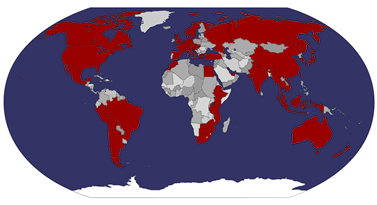Paraty is one of Brazil's prettiest colonial towns, whose centre has been declared a national historical monument in its entirety. It was the chief port for the export of gold in the 17th century and a coffee-exporting port in the 19th century. At the weekend Paraty buzzes with tourists who browse in the little boutiques and art galleries, or buy souvenirs from the Guarani Indians who sell their wares on the cobbles. Many of the numerous little bars and restaurants, like the pousadas, are owned by expat Europeans, who are determined to preserve Paraty's charm.
Beautiful Paraty
We arrive in Paraty [GPS:23.22029S, 44.71184W], it's hot, but for once this is much appreciated after the ice-box bus. No map of town, so I just wander. In a few minutes I arrive at the old town, or historical centre, where cars are not allowed. Cobbled is not the word. A random pile of large stones bridging the gap between houses would be a better one. I guarantee sprained ankles are the number one medical issue here. The term for the stones is "pes de moleque", or "street urchin's feet". Some of the streets flood at high-tide, so there are planks across junctions. Buildings all have whitewashed walls with colourful pastel shades decorating window frames and edgings. All low rise, all old buildings. Very pretty. All "hotels" are pousadas, which I believe means guesthouse or bed and breakfast, using colonial houses for accomodation.

I find Pousada Arte Colonial, where I am to stay, after about 20 minutes, and am warmly greeted by Nicole, the lady with whom I had been communicating via email over my reservation. She immediately prepares breakfast for me, which was much appreciated. My room is also simple but lovely, with a big bed, and small balcony overlooking a street leading to a church, St. Rita's.

Looking left..

Looking right..

Excuse the mess, I'd just arrived!

My room top right window
Nicole and Patrick. my hosts, are French, from near Montpelier, but speak excellent English, and are extremely friendly, accommodating, and generous hosts. I later learn that they have only been running the Pousada for three weeks, for a friend, though they are treating this as a trial run with a view to setting up something similar themselves.
After a brief spell of internet, sending all those mails from Foz, I wander the town, ending up eating lunch at Casa de los Artizans, a restaurant near the fish market, where I have spaghetti with seafood, washed down by wonderfully-cold beer from a large frozen enamel jug. Fantastic.

The pasta

I have to confess this was just the first..

Pretty St. Rita's, just round the corner from the pousada
Back to the pousada for a little siesta, then I join Nicole and Patrick in the large living room, where we chat. Patrick makes me a caipirinha, which is a drink made with lemon, sugar, and Cachaça, a Brazilian spirit made from sugar cane, similar to rum. Delicious!

Here's one I enjoyed elsewhere
Patrick uses a blend of Cachaças from Paraty and "normal" stuff, because the Paraty spirit has a very distinctive flavour. It's good. I tell them about my travels, and they invite me to visit them in their house in France. Afterwards I wander out to find food and end up at a Brazilian Thai restaurant, where I order Tom Kha Soup (one of my favourites) and then steamed fish in banana leaves. The fish is enormous! I don't finish it, a shame as it's very tasty. Washed down with cervesa of course. Skol and Bohemia are the usual bottled beers, Brahma less frequent, or one can order "chopp" which is draft beer, sometimes Heineken, otherwise no idea!
Following day I decided to walk up the Caminata del Oro, the "Walk of Gold", which heads over the mountains for a few hundred kilometers and was the original road that gold was brought back along. My walk was based on the logic that it didn't look far on the map in reception. The map wasn't to scale.

Flintstone maps were durable but I tend to prefer paper
Actually it wasn't so bad, but there's just something about walking in intense heat and humidity that just drains you. I almost give up, and in fact do stop at a bus stop and wait for a bus back to Paraty, but after twenty minutes I give up waiting and carry on walking. I guess the rest was helpful. I make it to Fazenda Murycana, my destination. It's a place where they make cachaça, a spirit derived from sugar cane, similar in taste to grappa (sorry to Italians if you find this assessment insulting!!), or perhaps rum.

The all-important cane

And where they put it to make the drink

Still life..

Flower life
Returned back to Paraty by bus, stopping at the large supermarket slighty out from the centre, where I stock up on Xmas provisions, i.e. panettone cake and some food for picnics. Lunch at my "usual" place, then back for my siesta. One day in and the routine has been established!!




2 comments:
are you getting paid by the tourist board??
are you getting laid by the tourist board??
Post a Comment